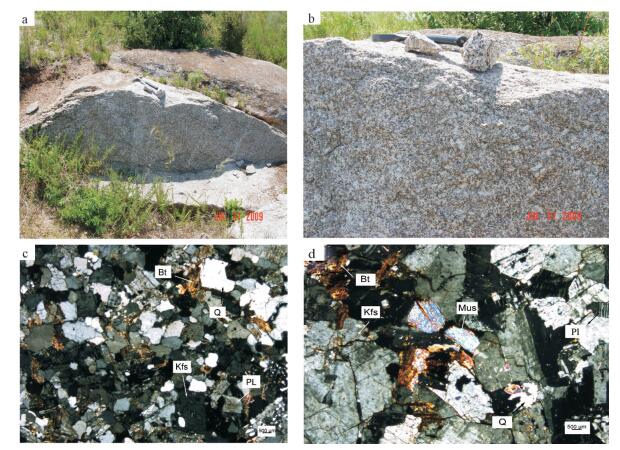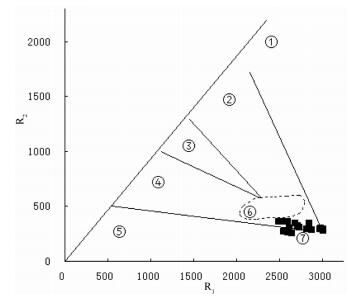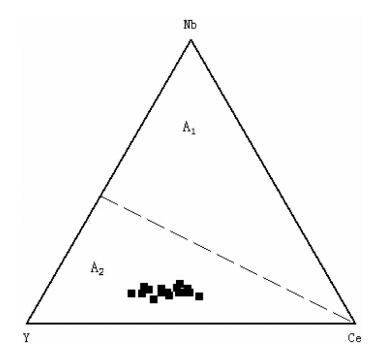Zircon U-Pb dating and tectonic significance of Shichang-shan pluton in central Da Hinggan Mountains
-
摘要:
对大兴安岭中部石场山侵入体进行了同位素年代学及岩石地球化学研究。测年结果表明,石场山侵入体似斑状细粒(细中粒)二长花岗岩LA-ICP-MS锆石U-Pb年龄加权平均值为201.69±0.72Ma和202.09 ±0.69Ma,表明该侵入体是晚三叠世侵位形成的。岩石学及地球化学成分显示其属于碱性、过铝质系列花岗岩。岩石具有高硅、富碱、高铁镁比、贫钙、贫镁和低钛特征。稀土元素配分曲线呈现“海鸥式”分布特征,显示强烈的负Eu异常。微量元素特征显示具有较高的Zr、Yb和Y含量,较低的Sr、B含量,微量元素原始地幔标准化蛛网图显示明显的Sr、Ba和Ti负异常。以上特征表明,石场山侵入体为铝质A型花岗岩。岩石具有高的Rb/Sr值和Rb/Nb值,显示壳源岩浆的成分特征。综合分析表明,本区似斑状细粒(细中粒)二长花岗岩为低压下长英质地壳部分熔融的产物。根据岩石构造环境判别,结合区域构造演化,认为似斑状细粒(细中粒)二长花岗岩为受前造山期控制下的伸展、裂解作用形成的。
Abstract:In this paper, the authors conducted geochronologic and geochemical studies of the Shichangshan pluton in central Da Hinggan Mountains. Zircon U-Pb dating demonstrates that the weighted mean 206Pb/238U ages for the zircons from the monzonitic granite are 201.69±0.72Ma (MSWD=0.04) and 202.09 ±0.69Ma (MSWD=0.12), suggesting late Triassic emplacement. Petrology and geochemistry show that it is of the alkaline and peraluminous series. The monzonitic granite is characterized by high SiO2 (73.77~77.69), high alkali (Na2O+K2O=6.7%~8.81%), high TFeO/MgO (7.24~45.57, 15.87 on average), low CaO (0.13%~1.01%), low MgO (0.08%~0.32%) and TiO2 (0.08%~0.31%). The monzonitic granite is characterized by a "sea-gull" REE pattern, significant negative Eu anomaly (δEu=0.04~0.61, 0.23 on average), depletion of Sr (18.31×10-6~67.91×10-6), Ba(50.07×10-6~265.5×10-6) and enrichment of Yb (5.09×10-6~17.33×10-6), Zr (91.34×10-6~192.26×10-6) and Y(35.44×10-6~113.07×10-6), suggesting that it is A-type granite. The high Rb/Sr ratios (ranging from 3.92 to 21.69, 10.14 on average) and Rb/Nb ratios (ranging from 13.9 to 54.8, 22.1 on average) of the rock indicate a crustal origin. A comprehensive analysis shows that the monzonitic granite was formed by low pressure felsic crust partial melting. In Na2O-K2O diagrams, it belongs to A-type granite. The Rb-(Y+Nb), Rb-(Yb+Ta), Nb-YCe diagrams in combination with regional tectonic evolution suggest that the monzonitic granite was formed in a post-orogenic setting.
-
致谢: 成文过程中承蒙沈阳地质调查中心李之彤研究员悉心指导并提出了宝贵的建议,在此表示衷心的感谢。
-
表 1 石场山侵入体主量、微量和稀土元素分析结果及特征参数
Table 1 Representative major, trace and REE data for the Shichangshan intrusion
样品编号 填图单位 岩性 SiO2 TiO2 Al2O3 Fe2O3 FeO MnO MgO CaO Na2O K2O P2O5 烧失量 总计 Na2O+K2O K2O/Na2O D7089 ηγbxT3 似斑状细中粒二长花岗岩 77.45 0.08 11.97 0.64 0.86 0.03 0.08 0.33 2.87 4.75 0.04 0.54 99.62 7.62 1.66 D6143 ηγbxT3 似斑状细中粒二长花岗岩 76.00 0.14 12.55 0.37 1.24 0.06 0.19 0.59 3.80 4.17 0.06 0.37 99.53 7.96 1.10 D4118 ηγbxT3 似斑状细中粒二长花岗岩 76.36 0.19 12.10 0.46 1.46 0.05 0.26 0.87 3.47 4.14 0.09 0.27 99.71 7.61 1.19 PM206-23-1 ηγbxT3 似斑状细中粒二长花岗岩 75.49 0.17 12.83 2.05 1.13 0.05 0.18 0.36 3.41 4.71 0.06 0.49 100.92 8.12 1.38 PM206-27-1 ηγbxT3 似斑状细中粒二长花岗岩 75.32 0.20 12.62 2.11 0.93 0.06 0.28 0.92 3.65 4.38 0.07 0.59 101.13 8.03 1.20 PM206-31-1 ηγbxT3 似斑状细中粒二长花岗岩 77.01 0.31 11.27 2.68 1.19 0.07 0.28 0.58 3.97 2.74 0.12 0.76 100.95 6.71 0.69 PM206-31-2 ηγbxT3 似斑状细中粒二长花岗岩 77.08 0.31 11.30 2.68 1.06 0.07 0.28 0.58 3.96 2.74 0.12 1.46 101.62 6.70 0.69 PM206-38-1 ηγbxT3 似斑状细中粒二长花岗岩 73.77 0.22 13.22 2.61 1.53 0.07 0.29 0.85 3.63 4.31 0.09 0.77 101.34 7.94 1.18 PM206-42-1 ηγbxT3 似斑状细中粒二长花岗岩 73.79 0.22 13.24 2.61 1.49 0.07 0.29 0.86 3.62 4.31 0.09 0.25 100.84 7.93 1.19 PM206-49-1 ηγbxT3 似斑状细中粒二长花岗岩 75.03 0.23 12.53 2.58 1.96 0.06 0.32 1.01 3.56 4.30 0.09 0.13 101.80 7.85 1.21 PM206-49-3 ηγbxT3 似斑状细中粒二长花岗岩 75.06 0.22 12.23 2.65 1.67 0.07 0.30 0.83 3.44 4.07 0.12 0.64 101.30 7.51 1.18 PM203-7-1 ηγbxT3 似斑状细粒二长花岗岩 76.20 0.09 12.84 0.66 0.83 0.04 0.11 0.31 2.36 5.25 0.03 0.98 99.69 7.61 2.22 PM203-7-3 ηγbxT3 似斑状细粒二长花岗岩 76.30 0.10 12.47 0.62 0.90 0.04 0.12 0.39 3.27 4.66 0.04 0.82 99.72 7.93 1.42 PM203-15-1 ηγbxT3 似斑状细粒二长花岗岩 74.93 0.18 12.65 1.46 0.97 0.03 0.15 0.44 3.30 4.50 0.07 0.97 99.66 7.80 1.37 PM205-1 ηγbxT3 似斑状细粒二长花岗岩 75.82 0.09 12.63 2.38 1.73 0.03 0.09 0.16 3.34 4.84 0.03 0.33 101.46 8.18 1.45 PM205-9 ηγbxT3 似斑状细粒二长花岗岩 76.75 0.08 12.24 1.57 0.77 0.03 0.10 0.13 3.44 5.04 0.02 0.44 100.61 8.48 1.46 PM205-17 ηγbxT3 似斑状细粒二长花岗岩 77.69 0.08 11.44 1.31 0.84 0.03 0.11 0.52 3.28 4.62 0.03 0.69 100.63 7.90 1.41 PM205-21 ηγbxT3 似斑状细粒二长花岗岩 76.16 0.08 12.61 1.41 0.88 0.03 0.11 0.15 3.24 5.57 0.04 0.48 100.76 8.81 1.72 样品编号 qz an ab or A P An% c il mt ∑ DI A/CNK SI AR R1 R2 D7089 41.8 1.38 24.51 28.34 50.67 3.56 37.41 1.62 0.15 0.94 100 94.65 1.144 0.83 2.75 3012 276 D6143 36.05 2.57 32.38 24.84 51.67 8.12 30.37 0.87 0.27 0.55 100.01 93.28 1.061 1.92 3.73 2713 321 D4118 37.62 3.74 29.52 24.58 47.21 10.62 33.84 0.56 0.36 0.67 100.01 91.72 1.029 2.65 3.3 2844 345 PM206-23-1 35.86 1.4 28.72 27.74 53.83 4.03 33.37 1.6 0.32 2.07 100.01 92.32 1.13 1.57 3.14 2618 298 PM206-27-1 34.26 4.06 30.75 25.77 49.15 11.43 34.18 0.37 0.38 1.95 100.01 90.78 1.016 2.44 3.34 2598 358 PM206-31-1 41.06 2.09 33.54 16.18 42.84 8.96 22.24 1.01 0.58 2.31 100.01 90.78 1.07 2.61 3.61 2967 296 PM206-31-2 41.23 2.09 33.5 16.17 42.8 8.96 22.25 1.05 0.58 2.23 100.01 90.9 1.074 2.64 3.59 2978 297 PM206-38-1 32.91 3.64 30.6 25.32 49.08 10.49 33.42 1.23 0.41 2.65 100.01 88.83 1.084 2.36 3.14 2488 363 PM206-42-1 33 3.66 30.47 25.35 48.98 10.49 33.56 1.26 0.41 2.62 100.01 88.81 1.087 2.4 3.11 2494 364 PM206-49-1 33.79 4.39 29.6 24.99 46.9 12.08 34.95 0.39 0.44 2.89 100.01 88.38 1.015 2.55 3.21 2561 364 PM206-49-3 36.17 3.34 28.94 23.93 46.56 9.66 33.26 0.92 0.42 2.71 100.01 89.05 1.056 2.52 3.23 2687 342 PM203-7-1 41.79 1.32 20.25 31.4 50.07 2.9 44.2 2.83 0.17 0.97 100 93.44 1.269 1.15 2.12 3005 294 PM203-7-3 38.48 1.75 27.97 27.83 52.69 4.86 34.54 1.43 0.18 0.9 100 94.28 1.12 1.28 3.07 2818 296 PM203-15-1 37.46 1.75 28.28 26.98 52.01 5 33.68 1.74 0.35 1.58 100.01 92.72 1.14 1.47 3.03 2734 307 PM205-1 36.01 0.61 27.97 28.28 55.08 1.78 33.2 1.65 0.16 2.69 100 92.25 1.145 0.69 3.19 2593 266 PM205-9 36.49 0.48 29.09 29.73 57.91 1.38 33.19 0.95 0.15 1.57 100 95.31 1.079 0.93 3.51 2645 258 PM205-17 39.21 2.4 27.79 27.31 50.94 6.57 35.25 0.16 0.14 1.4 100 94.31 1.009 1.04 3.43 2873 286 PM205-21 35.01 0.5 27.32 32.83 59.33 1.32 36.84 1.07 0.16 1.57 100 95.16 1.085 0.99 3.06 2552 268 样品编号 Ba Rb Sr Y Zr Th U Nb Ta Ni V Cr Co Li Sr/Y Rb/Sr Rb/Ba D7089 80.42 343.31 26.71 87.33 91.34 8.24 4.76 17.82 2.61 6.24 8.73 13.89 3.29 23.60 0.31 12.86 4.27 D6143 50.07 318.39 28.60 54.71 111.42 10.61 2.97 12.81 2.91 2.43 8.57 17.48 1.02 94.95 0.52 11.13 6.36 D4118 98.26 240.98 53.35 66.02 128.75 11.49 8.95 11.26 4.21 2.97 11.85 23.61 2.26 84.99 0.81 4.52 2.45 PM206-23-1 92.93 246.86 34.64 58.05 121.26 10.35 3.07 13.72 2.26 6.50 9.70 13.21 2.41 22.78 0.60 7.13 2.66 PM206-27-1 155.07 304.40 38.61 52.23 165.86 4.72 4.30 12.51 2.10 4.64 13.11 20.38 2.68 38.31 0.74 7.88 1.96 PM206-31-1 115.36 231.15 42.85 54.84 163.02 12.22 4.74 13.19 2.23 5.21 14.48 22.76 3.93 73.19 0.78 5.39 2.00 PM206-31-2 265.33 625.50 67.91 50.52 168.52 13.35 3.04 11.41 3.58 2.10 12.22 17.34 2.53 188.79 1.34 9.21 2.36 PM206-38-1 94.59 260.27 44.76 51.96 137.44 14.60 6.83 14.29 2.91 4.64 8.25 22.39 3.90 90.92 0.86 5.81 2.75 PM206-42-1 76.99 285.93 45.38 41.03 131.35 15.42 5.43 12.53 2.34 3.99 10.69 18.52 5.50 134.32 1.11 6.30 3.71 PM206-49-1 107.58 223.89 57.10 35.44 126.41 50.25 10.86 6.78 1.02 4.09 10.09 22.12 3.70 88.14 1.61 3.92 2.08 PM206-49-3 96.96 222.16 53.97 51.13 144.58 18.02 7.42 11.73 1.42 3.83 11.21 16.33 3.93 66.61 1.06 4.12 2.29 PM203-7-1 80.89 391.24 20.75 91.98 106.94 21.52 3.58 19.22 2.37 6.89 6.65 27.36 1.66 27.83 0.23 18.85 4.84 PM203-7-3 82.89 366.34 23.41 90.43 102.27 17.97 1.71 20.11 1.91 7.31 5.08 34.31 2.80 102.94 0.26 15.65 4.42 PM203-15-1 143.91 305.91 39.86 83.15 192.26 22.39 0.71 22.06 2.24 7.60 9.56 41.65 2.33 87.67 0.48 7.67 2.13 PM205-1 69.23 397.16 18.31 103.46 94.39 8.41 2.40 22.01 3.16 7.73 7.92 12.54 6.09 34.09 0.18 21.69 5.74 PM205-9 86.94 340.33 21.45 113.07 101.01 9.31 4.43 20.33 3.74 11.06 6.90 14.16 3.86 11.82 0.19 15.87 3.91 PM205-17 98.43 275.12 24.62 85.56 98.90 7.26 5.47 18.13 2.67 7.66 5.23 26.30 3.69 5.86 0.29 11.17 2.80 PM205-21 103.44 343.77 25.93 106.47 98.17 5.89 3.06 16.09 3.16 7.52 3.89 18.16 2.74 6.30 0.24 13.26 3.32 样品编号 La Ce Pr Nd Sm Eu Gd Tb Dy Ho Er Tm Yb Lu (La/Yb)N δEu REE D7089 22.67 58.26 7.19 28.11 7.91 0.14 8.06 1.75 13.57 2.85 8.51 1.51 9.14 1.35 1.67 0.05 171.01 D6143 15.61 36.35 4.91 20.15 5.64 0.40 5.46 1.12 7.93 1.64 5.05 0.92 6.34 0.98 1.66 0.22 112.51 D4118 9.49 28.06 4.13 17.98 6.17 0.22 5.65 1.38 9.64 2.07 6.59 1.26 8.66 1.31 0.74 0.11 102.59 PM206-23-1 17.45 54.60 5.83 22.11 6.26 1.21 5.80 1.62 9.53 2.18 6.67 1.27 8.33 1.32 1.41 0.61 144.17 PM206-27-1 10.73 48.15 3.89 14.71 4.52 0.68 4.72 1.41 9.01 2.06 5.92 1.14 7.37 1.15 0.98 0.45 115.48 PM206-31-1 19.74 53.97 6.84 26.14 6.91 0.54 6.12 1.49 10.00 2.13 6.40 1.20 7.99 1.24 1.66 0.25 150.72 PM206-31-2 22.30 56.44 7.59 28.74 6.86 0.83 5.63 1.42 7.74 1.66 4.81 0.90 6.10 0.96 2.46 0.40 151.99 PM206-38-1 14.07 49.93 5.29 20.93 6.02 0.40 5.32 1.48 9.25 1.99 6.08 1.20 8.46 1.34 1.12 0.21 131.77 PM206-42-1 9.49 35.22 3.60 14.05 3.97 0.38 3.73 1.15 6.76 1.46 4.58 0.94 6.38 1.02 1.00 0.30 92.71 PM206-49-1 11.62 26.60 3.86 14.68 4.04 0.73 3.69 1.10 6.30 1.39 4.09 0.78 5.09 0.80 1.54 0.57 84.75 PM206-49-3 16.35 43.88 5.71 15.11 6.17 0.34 5.45 1.46 8.69 1.80 5.16 0.87 5.33 0.79 2.07 0.18 117.13 PM203-7-1 23.82 51.17 7.96 31.93 9.71 0.15 8.09 2.21 17.03 3.89 10.41 2.01 12.99 1.78 1.24 0.05 183.15 PM203-7-3 24.61 45.96 8.23 32.31 9.44 0.12 8.01 2.28 18.02 4.11 11.16 2.14 14.04 1.95 1.18 0.04 182.40 PM203-15-1 36.18 68.73 10.99 44.12 11.08 0.26 8.65 1.73 15.06 3.23 8.53 1.53 10.16 1.32 2.40 0.08 221.58 PM205-1 18.28 74.95 6.76 24.30 7.77 0.42 8.03 2.93 18.90 4.16 12.61 2.34 15.33 2.25 0.80 0.16 199.04 PM205-9 12.40 57.04 5.29 20.35 7.94 0.34 8.14 3.06 20.52 4.63 14.08 2.67 17.33 2.55 0.48 0.13 176.33 PM205-17 10.50 43.99 3.93 14.22 4.49 0.35 4.58 1.91 13.16 3.08 9.51 1.90 12.18 1.78 0.58 0.24 125.58 PM205-21 12.34 64.84 5.09 19.57 7.25 0.34 7.73 2.85 19.22 4.19 12.37 2.27 14.17 2.05 0.59 0.14 174.29 注:样品均由沈阳地质调查中心测试中心分析;主量元素含量单位为%,微量和稀土元素含量为10-6 表 2 石场山侵入体锆石U-Th-Pb同位素分析结果
Table 2 Zircon U-Th-Pb isotopic analytical results of Shichangshan intrusion
样品 点号 Pb/10-6 U/10-6 同位素比值 年龄/Ma 232Th/238U 208Pb/206Pb 206Pb/238U 207Pb/235U 207Pb/206Pb 206Pb/238U 207Pb/235U 207Pb/206Pb RM 203.7.1 1 18 505 0.4439 0.2169 0.0318〈4〉 0.4375〈76〉 0.0999〈12〉 202±2 369±6 1622±22 2 10 285 0.6261 0.2039 0.0317〈3〉 0.2189〈46〉 0.0501〈10〉 201±2 201±4 197±46 3 42 1241 0.6149 0.1782 0.0316〈3〉 0.2189〈25〉 0.0503〈5〉 201±2 201±2 207±23 4 9 289 0.2538 0.1000 0.0318〈3〉 0.2186〈108〉 0.0499〈24〉 202±2 201±10 190±112 5 8 180 0.4809 0.4673 0.0318〈3〉 0.7579〈237〉 0.1729〈50〉 202±2 573±18 2586±48 6 24 771 0.2925 0.1010 0.0318〈3〉 0.2184〈35〉 0.0498〈7〉 202±2 201±3 186±31 7 16 512 0.4029 0.1156 0.0318〈3〉 0.2196〈35〉 0.0501〈8〉 202±2 202±3 201±35 8 7 218 0.2851 0.1120 0.0318〈3〉 0.2195〈79〉 0.0501〈18〉 202±2 201±7 198±82 9 56 1853 0.1383 0.0488 0.0317〈3〉 0.2196〈21〉 0.0502〈4〉 201±2 202±2 203±19 10 44 1398 0.2576 0.0938 0.0318〈2〉 0.2193〈21〉 0.0500〈4〉 202±2 201±7 193±20 11 39 1195 0.2910 0.1318 0.0318〈3〉 0.2189〈27〉 0.0500〈5〉 202±2 201±2 194±22 12 13 282 0.5339 0.4821 0.0318〈4〉 0.7824〈197〉 0.1622〈35〉 202±2 587±15 2479±36 13 12 385 0.4135 0.1278 0.0317〈3〉 0.2196〈58〉 0.0502〈12〉 201±2 202±5 204±57 14 23 739 0.2833 0.0783 0.0318〈3〉 0.2198〈26〉 0.0502〈5〉 202±2 202±2 203±25 15 3 80 0.5789 0.1994 0.0319〈4〉 0.2183〈164〉 0.0479〈37〉 202±2 201±15 179±174 16 7 221 0.4715 0.1420 0.0318〈3〉 0.2189〈86〉 0.0500〈20〉 202±2 201±8 194±93 17 4 126 0.7256 0.2368 0.0318〈3〉 0.2194〈128〉 0.0500〈28〉 202±2 201±12 193±133 18 21 533 0.3169 0.3127 0.0318〈3〉 0.3750〈75〉 0.0856〈18〉 202±2 323±6 1330±40 19 13 378 0.6216 0.2073 0.0318〈3〉 0.2106〈54〉 0.0504〈12〉 202±2 202±5 213±56 20 33 1060 0.2685 0.0791 0.0319〈2〉 0.2190〈22〉 0.0499〈5〉 202±2 201±2 189±22 21 8 271 0.0628 0.0200 0.0318〈3〉 0.3753〈67〉 0.0857〈14〉 202±2 324±6 1331±31 22 9 257 0.4443 0.2100 0.0318〈3〉 0.3685〈92〉 0.0841〈21〉 202±2 319±8 1296±49 23 14 425 0.3644 0.1129 0.0318〈2〉 0.2189〈34〉 0.0499〈7〉 202±2 201±3 189±35 24 1 27 0.6177 0.1919 0.0318〈8〉 0.3277〈864〉 0.0748〈232〉 202±5 288±76 1064±623 25 4 106 0.4999 0.1614 0.0319〈4〉 0.2185〈152〉 0.0497〈34〉 202±2 201±14 179±160 D4118 1 10 276 0.5447 0.2109 0.0317〈4〉 0.3166〈86〉 0.0724〈40〉 201±2 279±16 996±113 2 19 566 0.3854 0.1338 0.0319〈3〉 0.2205〈56〉 0.0501〈12〉 203±2 202±5 198±56 3 10 293 0.4918 0.1971 0.0317〈3〉 0.3420〈131〉 0.078〈26〉 201±2 299±11 1153±66 4 69 3395 0.3193 0.2275 0.0176〈1〉 0.2629〈25〉 0.1082〈11〉 113±1 237±2 1770±19 5 36 1116 0.4525 0.1070 0.0318〈2〉 0.2197〈33〉 0.0501〈7〉 202±1 202±3 199±33 6 22 656 0.4520 0.1508 0.0320〈3〉 0.2200〈45〉 0.0499〈9〉 203±2 202±4 188±43 7 21 635 0.5641 0.1667 0.0317〈3〉 0.2197〈60〉 0.0502〈12〉 201±2 202±6 205±56 8 27 831 0.4927 0.1431 0.0317〈2〉 0.2206〈34〉 0.0504〈8〉 201±1 202±3 215±35 9 38 1113 0.6368 0.1895 0.0319〈4〉 0.2191〈47〉 0.0498〈8〉 203±3 201±4 184±39 10 11 320 0.6727 0.2130 0.0319〈3〉 0.2197〈61〉 0.0499〈14〉 203±2 202±6 191±63 11 42 1324 0.3505 0.0923 0.0319〈2〉 0.2198〈28〉 0.0500〈6〉 202±2 202±3 193±26 12 47 1402 0.4478 0.1573 0.0320〈2〉 0.2203〈23〉 0.0499〈5〉 203±1 202±2 190±23 13 21 615 0.7914 0.2190 0.0317〈2〉 0.2207〈42〉 0.0504〈9〉 201±2 202±4 216±43 14 29 882 0.4147 0.1287 0.0318〈3〉 0.2197〈36〉 0.0501〈7〉 202±2 202±3 200±36 15 13 407 0.2889 0.0925 0.0318〈3〉 0.2196〈59〉 0.0500〈13〉 202±2 202±5 196±62 16 27 835 0.4078 0.1225 0.0318〈3〉 0.2203〈32〉 0.0503〈7〉 202±2 202±3 207±32 17 22 656 0.4396 0.1408 0.0319〈3〉 0.2205〈38〉 0.0501〈8〉 202±2 202±3 200±39 18 20 635 0.3169 0.0959 0.0318〈2〉 0.2203〈37〉 0.0502〈8〉 202±1 202±3 204±38 19 24 722 0.4774 0.1564 0.0318〈3〉 0.2197〈34〉 0.0502〈7〉 202±2 202±3 203±30 20 25 752 0.4903 0.1378 0.0318〈3〉 0.2200〈31〉 0.0501〈7〉 202±2 202±3 202±31 21 8 264 0.0628 0.0175 0.0318〈2〉 0.2202〈128〉 0.0502〈29〉 202±2 202±12 206±135 22 33 969 0.4587 0.1618 0.0320〈3〉 0.2207〈38〉 0.0501〈7〉 203±2 202±3 199±33 23 21 583 0.4828 0.2397 0.0318〈3〉 0.2199〈86〉 0.0502〈16〉 202±2 202±8 202±73 24 15 483 0.3238 0.1023 0.0318〈3〉 0.2191〈45〉 0.0500〈10〉 202±2 201±4 193±47 注:0.3166〈86〉代表 0.3166±0.0086 -
李兆鼐, 权恒, 李之彤, 等.中国东部中、新生代火成岩及其深部过程[M].北京, 地质出版社, 2003:1-357. 吴福元, 孙德有, 林强.东北地区显生宙花岗岩的成因与地壳增生[J].岩石学报, 1999, 15(2):181-189. http://d.old.wanfangdata.com.cn/Periodical/ysxb98199902003 李之彤, 赵春荆.吉黑东部晚三叠世岩浆活动及其与板块构造的关系[J].中国地质科学院院报, 1988, 18:21-32. http://www.wanfangdata.com.cn/details/detail.do?_type=perio&id=QK000000265150 吴福元, 孙德有, 李惠民, 等.松辽盆地基底岩石的锆石U-Pb年龄[J].科学通报, 2000, 45(6):656-660. doi: 10.3321/j.issn:0023-074X.2000.06.021 吴福元, Wilde S, 孙德有.中国东部出露的最年轻侵入岩的锆石离子探针年龄[J].科学通报, 2001, 46(12):1048-1052. doi: 10.3321/j.issn:0023-074X.2001.12.020 吴福元, 杨进辉, 柳小明.辽东半岛中生代花岗质岩浆作用的年代学格架[J].高校地质学报, 2005, 11(3):305-317. doi: 10.3969/j.issn.1006-7493.2005.03.003 吴福元, 杨进辉, 张艳斌, 等.辽西东南部中生代花岗岩时代[J].岩石学报, 2006, 22(2):315-325. http://d.old.wanfangdata.com.cn/Periodical/ysxb98200602006 葛文春, 吴福元, 周长勇, 等.大兴安岭中部乌兰浩特地区中生代花岗岩的锆石U-Pb年龄及地质意义[J].岩石学报, 2005, 21(3):749-762. http://d.old.wanfangdata.com.cn/Periodical/ysxb98200503015 葛文春, 隋振民, 吴福元, 等.大兴安岭东北部早古生代花岗岩锆石U-Pb年龄、Hf同位素特征及地质意义[J].岩石学报, 2007, 23(2):423-440. http://d.old.wanfangdata.com.cn/Periodical/ysxb98200702021 武广, 陈衍景, 孙丰月, 等.大兴安岭北段晚侏罗世花岗岩类地球化学及其地质和找矿意义[J].岩石学报, 2008, 24(4):899-910. http://www.cqvip.com/Main/Detail.aspx?id=27734160 武广, 陈衍景, 赵振华, 等.大兴安岭北端洛古河东花岗岩的地球化学、SHRIMP锆石U-Pb年龄和岩石成因[J].岩石学报, 2009, 25(2):233-247. http://d.old.wanfangdata.com.cn/Periodical/ysxb98200902001 隋振民, 葛文春, 吴福元, 等.大兴安岭北部察哈彦岩体的Hf同位素特征及其地质意义[J].吉林大学学报(地球科学版), 2009, 39(5):849-856. http://d.old.wanfangdata.com.cn/Periodical/cckjdxxb200905013 徐美君, 许文良, 王枫, 等.小兴安岭中部早侏罗世花岗质岩石的年代学与地球化学及其构造意义[J].岩石学报, 2013, 29(2):354-368. http://d.old.wanfangdata.com.cn/Periodical/ysxb98201302002 许文良, 王枫, 裴福萍, 等.中国东北中生代构造体制与区域成矿背景:来自中生代火山岩组合时空变化的制约[J].岩石学报, 2013, 29(2):339-353. http://d.old.wanfangdata.com.cn/Periodical/ysxb98201302001 李之彤, 赵春荆.东北北部三叠纪A型花岗岩的初步研究[J].中国地质科学院沈阳地质矿产研究所集刊, 1992, 第1号:96-108. http://www.cqvip.com/Main/Detail.aspx?id=939389 秦克章, 田中亮吏, 李伟实, 等.满洲里地区印支期花岗岩Rb-Sr等时线年代学证据[J].岩石矿物学杂志, 1998, 17(3):235-240. http://www.cqvip.com/Main/Detail.aspx?id=3127966 吴福元, 林强, 葛文春, 等.张广才岭新华屯岩体的形成时代与成因研究[J].岩石矿物学杂志, 1998, 17(3):226-234. http://www.wanfangdata.com.cn/details/detail.do?_type=perio&id=QK199800956316 张兴洲, 杨宝俊, 吴福元, 等.中国兴蒙-吉黑地区岩石圈三维结构及演化[M].北京:地质出版社, 2011. Lu S T, Yang S G. The late Mesozic rifting in the northeastern China and the faultrifting basins in East Asia[J]. Science in China(Series B), 1987, 21:185-195.
陈义贤, 陈文寄.辽西及邻区中生代火山岩-年代学、地球化学和构造背景[M].北京:地震局出版社. 1997:1-279. Wu F Y, Wilde S A, Zhang G L, et al. Geochronology and pet rogenesis of post-orogenic Cu, Ni-bearing mafic-ultramafic intrusions in Jilin, NE China[J]. Journal of Asian Earth Sciences, 2004, 23:781-797. doi: 10.1016/S1367-9120(03)00114-7
付俊彧, 宋维民, 庞雪娇, 等.内蒙古科尔沁右翼中旗地区古生界疑源类化石及其时代[J].地质通报, 2012, 31(9):1404-1409. doi: 10.3969/j.issn.1671-2552.2012.09.005 Yan M C, Chi Q H. The Chemical Compositions of the Continental Crust and Rocks in the Eastern Part of China[M]. Beijing:Science Press, 2005:1-171.
Hofmann A W. Chemical differentiation of the Erth:the relation-ship between mantle, continental crust, and oceanic crust[J]. Earth and Planetary Science letters, 1988, 90:297-314.
张旗, 王焰, 李承东, 等.花岗岩的Sr-Yb分类及其地质意义[J].岩石学报, 2006, 22(9):2249-2269. http://d.old.wanfangdata.com.cn/Periodical/ysxb98200609001 宋彪, 张玉海, 万渝生, 等.锆石SHRIMP样品靶制作、年龄测定及有关现象讨论[J].地质论评, 2002, 48(增刊):26-30. http://d.old.wanfangdata.com.cn/Periodical/OA000005931 Ludwig K R. Isoplot-A plotting and regression program for radio-genic-isotope data. US Geol. Survey Open-File Report[J]. 1994, (39): 91-445.
Whalen J B, Currie K L, Chappell B W. A-type granites: Geochemical characteristics, discrimination and petrogenesis. Contributions to Mineralogy and Petrology[J]. 1987, 95: 407-419.
张旗, 王焰, 熊小林, 等.埃达克岩和花岗岩:挑战与机遇[M].北京:中国大地出版社, 2008:1-344. 贾小辉, 王强, 唐功建. A型花岗岩的研究进展及意义[J].大地构造与成矿学, 2009, 33(3):465-480. doi: 10.3969/j.issn.1001-1552.2009.03.017 张允平, 李景春.华北及其以北地区晚古生代-早中生代构造格架主体特点[J].中国地质, 2010, 37(4):916-930. doi: 10.3969/j.issn.1000-3657.2010.04.008 Webb L E, Johnson C L. Tertiary strike-slip faulting in Southeastern Mongolia and implications for Asian tectonics[J]. Earth and Planetary Science Letters, 2006, 241:323-335. doi: 10.1016/j.epsl.2005.10.033
Webb L E, Johnson C L, Badarch G, et al. Evidence for an Early Mesozoic mylonitic sinistral shear zone in Southeastern Mongolia[J]. Research Gate, 2015:43-45.
Ulmishek G F. Petroleum Geology and Resources of the West Siberian Basin, Russia[M]. U.S. Geological Survey Bulletin, 2009, 2201-G, 2003.
Jahn B M, Litvinovsky B A, Zanvilevich A N, et al. Peralkaline granitoid magmatism in the Mongolian-Transbaikalian Belt:Evolution, petrogenesis and tectonic significance[J]. Lithos, 2009, 113(3):521-539. http://www.sciencedirect.com/science/article/pii/S0024493709002643




 下载:
下载:











